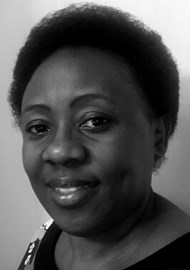
A selection of participants in an MDT meeting with Uganda.
In 2017 the LINKS Programme developed a new network of LINKS to support and coordinate action against retinoblastoma (Rb) in response to requests from low- and middle-income countries (LMICs), called the Retinoblastoma Network, or Rb-NET. The process of setting up Rb-NET was described in Eye News in 2018 [1]. In addition, one of the LINK partnerships participating in Rb-NET featured in Eye News last year [2].
This article highlights the way that Rb-NET has adapted to meet the challenges posed by COVID-19 while maintaining input into the management of children with Rb in LMICs and supporting the training and development of Rb specialists from a multidisciplinary perspective.
Retinoblastoma is a rare but deadly cancer, which affects approximately 9000 children globally per year. It is the most common ocular malignancy of childhood, with an incidence estimated at 1:18,000 live births. In high-income countries, with specialised Rb treatment centres, almost all children survive, and most eyes do not have to be removed. However, in LMICs, particularly in Africa, mortality is typically around 70%.
Rb-NET
Rb-NET is formed of 10 Rb treatment centres in six sub-Saharan African countries (Tanzania, Uganda, Malawi, Kenya, Nigeria and Zimbabwe), which are linked with experts from specialist Rb centres in the UK, India, Israel, Europe and the USA. Having Rb-NET partner experts in India is vital because they are familiar with the challenge of treating Rb in children who have presented late, with advanced disease. Advances in detection in countries such as the UK and USA mean that Rb specialists in these countries have less experience of treating children with advanced disease than their counterparts in India. The expertise offered by the Rb-NET includes paediatric oncology, ophthalmology, pathology, imaging, nursing and counselling.
Virtual Multidisciplinary Team (MDT) meetings
With the onset of COVID-19, it became impossible to travel for training and Rb-NET workshops. The LMIC partners requested that Rb-NET offer online training support instead of face-to-face. The objectives of the online MDT meetings were:
- To improve the quality of care of children diagnosed with Rb in remote and rural areas
- To support global eye health during the COVID-19 pandemic
- To facilitate sharing and dissemination of knowledge about Rb via a virtual educational platform.
During 2020, eight virtual MDT meetings were held with national Rb teams from Kenya, Tanzania, Malawi, Uganda, Nigeria and Indonesia. Further MDTs are being held in these, and other, countries in 2021.
The MDTs feature presentations of three or four cases per session, each causing challenges for the team managing the children. The presenter of each case uses Powerpoint slides to describe the child’s medical history and shows fundus images and scans as required to assist the international experts to understand the extent of disease, treatment to date, progress against the disease achieved and the dilemmas currently faced.
Following each presentation there is a full and open discussion about the case, with the international experts contributing suggestions as to how best each child can be managed, within the limitations of the options available in the country.
Examples of cases presented during MDT meetings
Two of the cases presented during Rb-NET MDTs held during 2020 follow:
1. Case presented by Elizabeth Nkanga, Calabar Children’s Eye Centre, Cross River State, Nigeria
A two-year-old child arrived at the Children’s Eye Centre from a rural community in Cross River State. He presented with right leukocoria of four months, left leukocoria of one month and progressive painless loss of vision of one month. The child was irritable and small for his age with a right esotropia and sub-mandibular lymphadenopathy.
Challenges:
- The child did not attend for follow-up for a year after the first visit as the parents went to seek alternative care from a traditional healer.
- By the second visit the patient presented with loss of vision of 13 months, progressive right proptosis and increasing left leukocoria.
- No possibility of getting an MRI.
- Social worker intervention was requested for appropriate tracing and waiving of hospital bills, as parents could not afford to pay.
- Parents have been consistently attending hospital visits in the past two months.
- COVID-19 did not affect follow-up at the Centre.
Questions and discussion:
- Dr Nkanga was asked what measures were in place to persuade the family to let the child have treatment at the first visit. She advised that counselling was in place, but the counselling team was not properly trained a year ago, and they had benefitted from retraining sessions since then.
- One of the international experts advised the team to think about palliative care in place of further sessions of chemotherapy, as chances of survival were slim.
- Colleagues in other centres in Nigeria suggested a) that senior doctors might sit down with parents and counsel them at the initial visit and b) the need for an early community detection programme to save sight and lives, and which will save the centres and the families the cost of chemotherapy treatments.
2. Case presented by Anne Musika, Mulago Hospital, Kampala, Uganda
An Eritrean child of refugees arrived at the hospital with unilateral Rb (Group D). The tumour was large and obscuring the retina. An MRI showed that there was no tumour in the optic nerve. Dr Musika is benefitting from working closely with the paediatric oncologist in the treatment of the child. Enucleation and subsequent chemotherapy were suggested. However, the parents did not want the eye removed. The child was put on nine cycles of vincristine, etoposide, carboplatin (VEC) chemotherapy. Midway through treatment there was significant thrombocytopenia and a bone marrow biopsy and analysis of the cerebrospinal fluid were both positive for malignant retinoblastoma cells. The child has a dense cataract in the affected eye, making it difficult to see the tumour.
The international experts felt that Dr Musika was fortunate to have a paediatric oncologist to help in the treatment of the child and it was good that there had been a bone marrow biopsy, not just aspiration. If there was bone marrow invasion, the only option to save the child is bone marrow transplantation. As that is not feasible, metronomic chemotherapy might help – continuous low doses – to control the tumour for a few months. It was necessary to enucleate the eye as soon as possible even though the parents were resistant. The experts suggested temozolomide was a useful drug in palliative care, but it is expensive and may not be available.
If there was doubt about the diagnosis, the team offered Dr Musika the option to share slides and MRIs for further advice. Dr Musika said that a lot of parents refuse enucleation at first and they go to other hospitals. Continuity of care is also a challenge as some patients travel a long way to get treatment. Keith Waddell of Ruharo Eye Centre in Mbarara said that he uses chemoreduction initially as a way of buying time: to keep the family coming back for treatment and seeing other children who have prosthetic eyes, and gradually being willing to accept enucleation of their own child’s eye.
Common themes emerging
While every case has been different in its details, common themes have emerged from the MDTs held to date that highlight the challenges facing those treating children with Rb in LMICs. These include:
- Delayed presentation due to lack of awareness of the signs of Rb amongst the community and, often, healthcare workers.
- Parents feel concern about the cosmetic effects of enucleation; there is sometimes a lack of prosthetic eyes.
- There may be initial refusal of treatment while other avenues are explored – often resulting in a long delay until returning to hospital, by which time the disease has become incurable.
- Family support groups, to help counsel and support families newly affected by Rb, are rare.
- Cost of scans, chemotherapy etc. may be prohibitively expensive for the family; the ophthalmologists and eye departments are forced to try to find funding themselves to enable the children to have chemotherapy.
- There may be fewer treatment options than are available in higher-income countries, especially for advanced cases, such as lack of localised chemotherapy, or no access to radiotherapy.
Summary
The development of virtual MDT meetings was driven by the effect of the COVID-19 pandemic making travel for training impossible. The use of Zoom discussions is proving to be an effective way of providing advice and support for Rb-NET colleagues in LMICs. It is a popular and convenient option for the team of international experts, who are informed well in advance and are willing to set aside a specific time for the session. There are benefits to both sides, as the LMIC colleagues can engage in discussion and question the experts about specific cases, while the experts can immediately see the benefits of sharing their knowledge. There are wider benefits, as the MDTs become better known and more people from the bigger LMICs, such as Nigeria, join in. So popular are the MDTs that a website has recently been set up to host them so that the learning can be shared more easily and widely [4]. It is planned that the regular Rb-NET virtual MDTs will continue even after travel for training becomes feasible again.
References
1. Williams P, Bowman R, Foster A, et al. Rb-NET: a network to save life and preserve vision in children in Africa. Eye News 2018;24(6):32-4.
2. Makan M, Reddy MA, Naeem Z, et al. Development of retinoblastoma services in Zimbabwe. Eye News 2020;27(1):22-5.
3. Global Retinoblastoma Study Group; Fabian ID, Abdallah E, Abdullahi SU, et al. Global retinoblastoma presentation and analysis by national income level. JAMA Oncol 2020;6(5):685‑95.
4. Rb-NET website: RB NET MDT (rb-net-mdt.org)
5. Queen Elizabeth Diamond Jubilee Trust: www.jubileetribute.org
Benefits of Rb-NET MDTs:
-
Friendly, supportive atmosphere. Rb-NET experts sensitive to the local conditions. Most of the expert contributors have worked in or with LMIC eye departments.
-
Plenty of time for case presentations without interruption. Cases presented on Powerpoint, which works well via screen sharing on Zoom.
-
Clear, open communication about cases, the clinical decisions made to date and the issues faced. Lack of facilities / equipment / treatment etc accepted by all as a matter of fact.
-
Questions and discussion section gets down to the nitty-gritty of what the next steps are in the specific circumstances
-
Empathetic to the plight of the affected children and their families, with an emphasis on making the last days / weeks / months of a child’s life as bearable as possible. Not shying away from accepting that in many cases palliative care at home is the best and only option.
-
Advice about how to access care in other neighbouring countries, when necessary.
-
Advice about promoting awareness and screening.
Acknowledgement: The authors acknowledge with gratitude the financial support of the Queen Elizabeth Diamond Jubilee Trust [5] in establishing the Rb‑NET as part of the Commonwealth Eye Health Consortium. Funds are needed to support the work of the Retinoblastoma Network. Anyone who can help is asked to contact Marcia Zondervan.
COMMENTS ARE WELCOME










